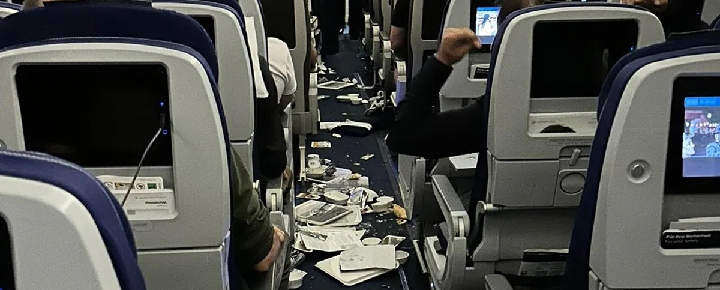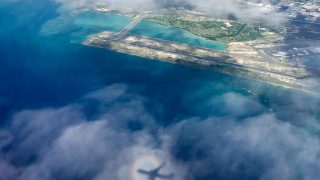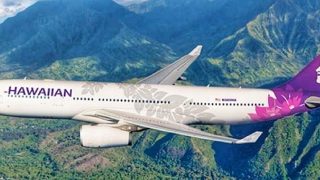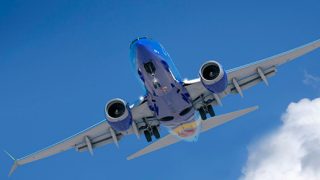News of another severe air turbulence event on Hawaiian Airlines is just now coming to light. As a result, some passengers were evacuated to the hospital upon landing, after the flight hit severe turbulence half-way to its destination.
The passengers were onboard HA 451, a flight BOH editors have enjoyed many times. The Airbus A330-200 departed Honolulu yesterday (Thursday) at 12:47 pm, and landed in Sydney at 7:58 pm (Friday). There were 175 passengers and crew onboard the plane.
Half-way through the flight, Hawaiian Airlines encountered extreme turbulence.
The flight was at about five hours into the 11 hour and 11 minute flight when very strong winds impacted the plane. Kingsford Smith Airport in Sydney was notified, and first responders including ambulances met the aircraft on arrival.
“Service from Honolulu to Sydney encountered unexpected severe turbulence” — Hawaiian Airlines.
Hawaiian’s spokesperson told news media that “Four passengers and three flight attendants were initially treated by a doctor onboard and our crew members, in consultation with physicians on the ground.” After landing, local paramedics came onboard and evaluated twelve passengers for injuries, with an unknown number of those taken to local hospitals. It is believed that the injuries were minor but we could not confirm that.
Hawaii said that the flight back to Honolulu (HA452), would await what they called a “thorough inspection.” The inspection must have gone well, inasmuch as that flight got in the air just 40 minutes later than expected, and is currently en route to Honolulu, with an estimated arrival time of 11:30 am today (Friday).
Hawaii added that “Our Immediate priority is to continue to care for our passengers and crew affected by this turbulence event, and we thank Sydney Airport first responders for their swift assistance.”
Prior Hawaiian Airlines Flight 35 turbulence event injured dozens.
A prior Hawaiian Airlines mass casualty incident hasn’t been forgotten. In that event, HA 35 encountered extreme clear-air turbulence on December 18 of last year when it was approaching Honolulu. Three dozen people were injured, with 20 going to the hospital, and 11 seriously injured following the turbulence that resulted in an altitude drop that sent passengers smashing into overhead luggage bins and the aircraft ceiling. The flight crew asked for trained medical or firefighters to step forward to help prior to landing.
Unlike today’s incident, which occurred five hours prior to landing, HA 35’s issues occured just prior to its descent, and about 1/2 hour before landing.
It isn’t clear if the seatbelt sign was on, but…
The plane was cruising at a high altitude when the event occurred. We don’t yet know if the seatbelt sign was illuminated or not when the turbulence struck. We certainly have changed our attitudes about staying buckled up at all times on airplanes. That partly came as a result of the Flight 35 incident. It’s obvious that airlines, as much as they would like to, and despite all of the technology, still don’t have a complete crystal ball regarding turbulence.
Get Breaking Hawaii Travel News






The aircrafts design, that is the aircrafts aerodynamic configuration can help to mitigate the most negative effects of turbulence. Aircraft with an engineering design objective of high altitude high speed flight vs. economical efficient cursing tend to preform with a more robust ability to tolerate turbulent air. All aircraft regardless of type will feel the effect of clear air turbulence. Some aircraft types have a history of preforming better than others in this regard. There are a number of factors in play and the possibility of a bumpy or harsh flight conditions cannot be unexpected.
Always keep your seat belt fastened no matter what……
Safety first ….. pilots cannot control the weather or when
turbulence is going to hit. or birds
Glad the plane landed safely….
Mahalo
Julie M
I also happened to notice that yesterday (6/29) the Hawaiian flight Honolulu to Pago Pago appeared to turn around mid flight and return to HNL. I haven’t read or heard anything about this.
Hi Alan.
Welcome and thanks for that! Collin mentioned that he’d told you about Beat of Hawaii.
Aloha.
Hi I’ll still fly it happens to any flight.
Long time airline pilot: The only way clear air turbulence can be avoided is if a flight encounters it and reports it to ATC. Over land or over ocean it’s position is reported by distance to or from a waypoint, and altitude is also reported. Unfortunately, the first aircraft to encounter that turbulence has no advance warning. That’s why, although the seat belt sign is off so that people can use the restroom, it’s critical to get up, got, then get back in your seat and buckle your seatbelt asap. I had a very serious incident once over the Mediterranean and made an emergency landing: one passenger had three broken vertebrae and the other a complete skull fracture requiring emergency surgery. It was very distressing, so please keep your seat belt fastened, and stay in your seat unless absolutely necessary.
mass casualty infers that people died which they didnt…
Hi Riley.
The definition of casualty includes injuries.
Aloha.
Some folks have wondered why pilots cannot “see” turbulence on their aircraft radar.
Pilots cannot “see” clear air turbulence (CAT) on a conventional aircraft radar. One can see WX (weather), storms, and thunderstorm cells from which turbulence emanates and make judgments based upon experience and what is being viewed … but to “see” turbulence on radar?? Not going to happen …
There are systems such as LIDAR (laser based) that can detect CAT but those upscale radars are generally not installed on commercial aircraft.
If only three people were hurt, I hope it means the majority of passengers were wearing their seatbelts. It might be uncomfortable, but airlines do strongly suggest you keep your belt on during the flight.
Hi Dot.
Good to hear from you! We have some conflicting information about the number injured, but it is relatively small, especially in comparison with that prior HA 35 incident.
Aloha.
Thanks for this post. I am very tall, so about hour 6 or 7, I start to get so antsy and am up and down walking around so much. I know it is not proper or safe, but the seats on these airplanes are getting shorter pitches and it is just miserable.
I feel for the people that got hurt and I hope they get well soon. As far as turbulence, doesn’t that show on Radar and doesn’t the Captain and his crew look at the radar and a flight plan before? Does turbulence just show up out of nowhere?Also, do people…..passengers really need to be babysat by needing to have them be reminded to wear seat belts while on flight! How much babysitting do people need! Gosh!!! I know that all the responsability falls on the Airline and the crew of the Airline but People also Need to be responsible!!!!!!!!! Airlines and their crew aren’t they babysitters, their maids, their slaves etc!!!!! Enough already!! People need to Grow Up!!!!
No… turbulence doesn’t show up on radar. Yes, turbulence can show up out of no where.
If they were a small number of injuries it could be someone was in the bathroom or got up to stretch their legs or went to get a drink. Let’s hope that is the case.
CAT isn’t really that easy to see on radar, it can pop up suddenly as happened to HA35. A flight plan only tells others what your intended route is not what the weather is about to be. This incident happened over the vast Pacific where there is less air traffic so any preceding planes may have been in clear smooth air with nothing to report.
All that being said, it is good advice to keep your seat belt fastened when seated regardless of whether the seat belt sign is lit or not.